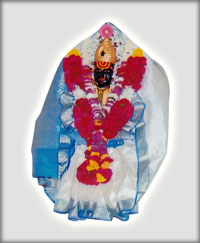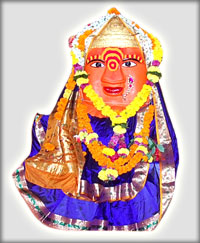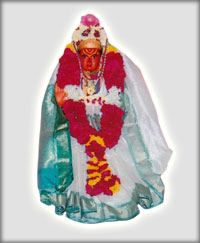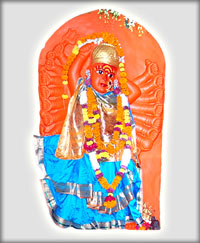Three & half Shaktipeethas of Maharashtra

In India there are 62 well known Shakti Peethas (According to some experts it is 108). In Maharashtra there are three and half Shakti Peethas. In them Kolhapur's Aambabai, Mahur's Renuka, Tuljapur's Bhavani Mata are known as Purna Peetha (Full Peethas), Vani's Saptshrungi is known as 'Half Peetha'
1) Tuljapur

Tuljapur is situated in osmanabad distriet, is well known as family deity of many people of Maharashtra. Tuljabhavani's ancient temple is known for an excellent example of Hemandpanthi Sculpture. It is situated at a distance of 19 km. from Osmanabad and 40 km from Solapur. The former name of Tuljapur was Chinchpur. After Yadava rule in Shivaji's rule grandeur of Tuljabhavani increased. 'Tulja' name is given on the base of Tvaraja/ Turaja. The height of devi's idol is 3ft. It has a plate of forming idol's back Prabhaval . It is standing on the throne. The image is made of Black stone (Pashan). Her head is covered with crown. One lock of lair is came out from the crown. The image is with eight hands, with a quiver on her back. On the right & left side of her face, there are moon and sun respectively her right leg is on Mahishasur (monster) to the right of Mahishasur there is idol of sage Markaday with lion on his back everyday four times pujas are performed. Thrice in a year the goddess is in slumber. Among all the festivals Navratri is the biggest festival. In these nine days, Mahapuja is offered. Every night of Navratri, a procession of Chhabina is performed with every vehicle of Devi. Tuljabhavani Mata, which is family deity, is an inspirsational goddess. It is also called as family deity of Maharashtra.
2) Mahur's Renukadevi

Mahur is situated in Nanded district. which was formerly known as Matapur. Mahur is said to be the birthplace of Renuka, daughter of king Renu. She was arose From sacrificial fire puja. She was the wife of Jamadgani. This palce is situated on the border of Marathwada and Vidharbha. It is situated at the distance of 45 km from Nanded and Kinvat, which is covered by mountains. This place is famous as one full Peetha of three & half Shaktipeetha, Sleeping place of Lord Dattatraya. and penance place of sages. Due to these magnificances a large number of pilgrims visit throughout the year. Renuka Mata is also called as Ekeveera. The temple is at the pinnacle of mountain. The architecture of temple is of an ancient type. In sanctum instead of image (idol) there is Tandala. Shape of face is given over it with sliver wig. On her seat lion is carved. The face of Devi look magnificant and firece. Near Mahur there is Lord Dattatraya's place Mahur is also known as prominent place of Mahanubhava sect. Parshuram (Renuka's son) cremated Jamadgani, So Renukamata went as sati at the same place. Because of this reason Mahur is prominent place of Renukamata crushed betel leaves are given as a prasad to devotees.
3) Kolhapur

Kolhapur is situated on Pune-Banglore highway at the distance of 125 km. from Pune. Kolhapur's Aambabai is family deity of Maharashtra and Karnataka. As listed in Skanda Purana (myth) Kolhapur is called as Dakshin Kashi. In 2nd century of A.D. this place was burnt in fire But in the 8th century A.D. it was rebuitt. The temple is in Trishul (one of the weapons of Lord Shankar) shape facing to the west. The architecture of the temple is of Hemandpanthi type, which was built in reigns of many kings. In the temple, there are four stone inscription in Devnagari language. The image of Ambabai is carved in blace stone. In her four hands, the deity holds objects of symbolic value. The lower right hand holds a Mhalunga (a citrus fruit) in the upper right hand a large mace (Kaumodaki) with its head touching the ground, in the upper left a shield (Khetaka) in the lower left a bowl (Panpatra). Devotees believe that there is unification of Brahma, Vishnu and Mahesh in Ambabai. This place is also called as Karveer because in the ancient time. She saved this place with her mace (Gada) to stop flood. According to another story, She killed Kolhasur (the name of demon) on the mountain. So this place is named as Kolhapur. Throughout the year there are three special days. Chaitra full moon day, 5th day (Panchami) of Ashwin Shuddha and full moon day of Ashwin Shuddha. In Navratri, on the 8th day (Ashatami) sacrificed fire puja is performed. Every Tuesday, and Friday Abhishek of "Shrisukta" is offered to the goddess. This image looks west (Pashim). Due to the architechural speciality, through western window, the light of the setting sun falls on the face of the image for three days in the month of Magh. During Navratri daily Mahapuja and other religious activities are performed with great enthusiasm.
4) Saptashrungi - Half Peetha

Saptashrungi (Vani) is situated in Kalwan Taluka at the distance of 56 km from Nasik. This palce is considered as base Peetha of three and half shaktipeetha. Around 700 steps, temple hall, Queues for Darshan are newly constructed. Sage Markandeya had done deep penance at this place. Devi pleased with his penance and told him to build her temple. and establish her idol. So the mountain infront of the temple is called as Markandeyas mountain. This place dwells within the seven mountain peaks (Sapta mean seven and shrunga means (peaks). That's why this place is called as Sapta-Shrungi. But now-a-days we can see four mountains so it is also called as Chatur-Shrungi. The name of mountain is called as Saptashrungi. This place is situated at the height of 4500 ft from the sea level. The Devi is said to be swayambhu (self manifested) on a rock on the sheer face of a mountain. The height of image is approximately 8 to 10 ft. standing with 8 hands. The Devi's image is painted bright red with ochre called Sindoor. It faces the east with left hand on the ear. The images is slightly inclined towards the left. Annual fair is held on full moon day of Ashwin.
